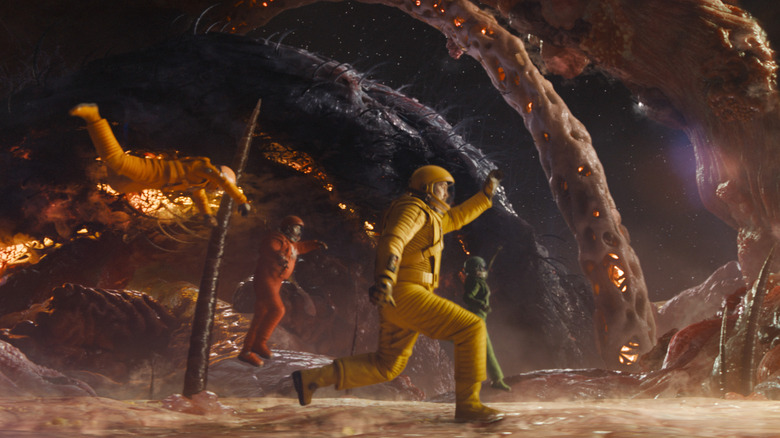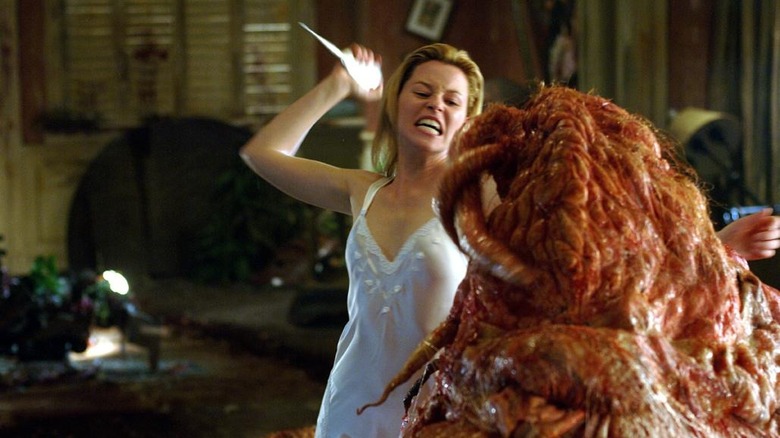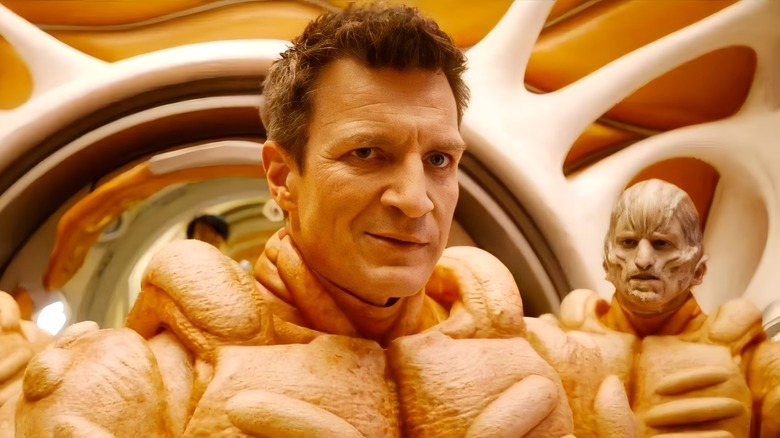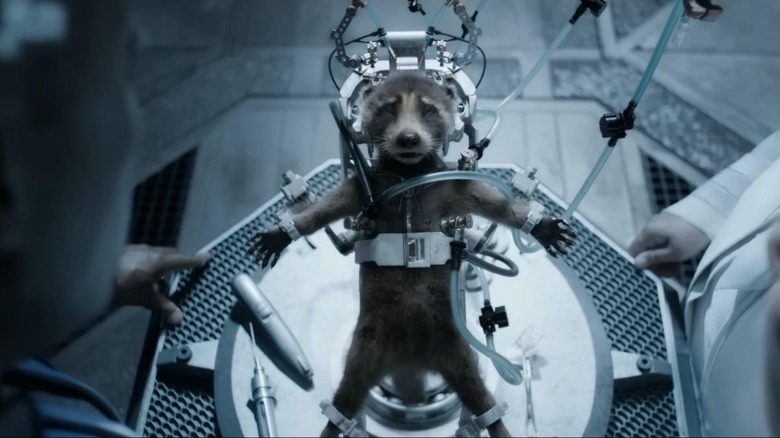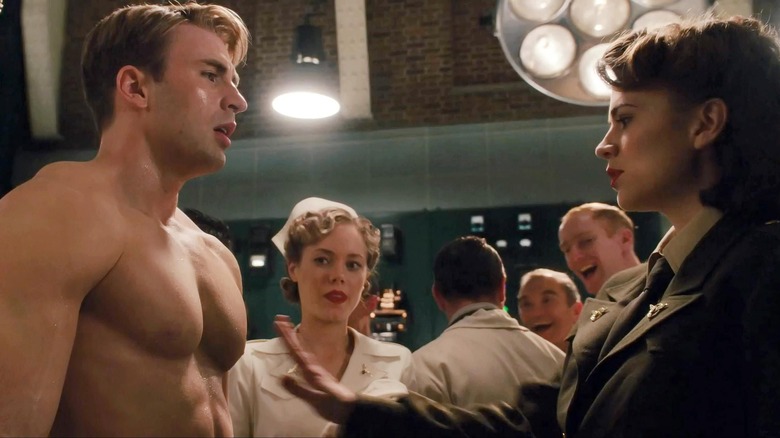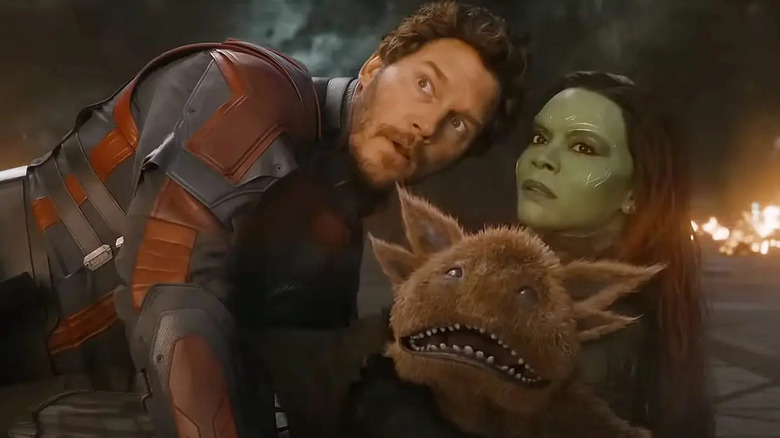How Guardians Of The Galaxy Leans Into James Gunn's Violent, Gooey, Horror-Centric Past
This article contains spoilers for "Guardians of the Galaxy Vol. 3."
The "Guardians of the Galaxy" films are without a doubt the most aesthetically diverse entries within the Marvel Cinematic Universe. Far from being just another superhero saga, the films blend elements of comic-book-style derring-do, soap opera, space opera, action-adventure, and character-based melodrama.
But one particular element that writer/director James Gunn has continually brought to all three "Guardians" films is horror. For those not particularly well-versed in the genre, the horrific aspects of the "Guardians" movies may simply seem "edgy," but to those who are aware of Gunn's horror-soaked past as a filmmaker, these elements stick out like a big, fleshy tentacle.
The latest (and, for Gunn at least, last) installment of the saga, "Guardians of the Galaxy Vol. 3," is no exception to showcasing Gunn's horror roots. On the contrary; it may be the goopiest, most intense, upsetting, and transgressive of all the "Guardians" movies, proving not only that Gunn hasn't lost his horror bonafides, but that horror can enrich other genres in a powerful way.
Gunn slithers into filmmaking
Like most kids growing up during the horror movie boom of the '70s and '80s, a young Gunn took his first steps into filmmaking by shooting 8mm horror films with his friends. As he explained in a 2011 interview with St. Louis Magazine, horror gave him the confidence to even attempt filmmaking in the first place:
"Strangely, the two movies that affected me — and maybe not in the way most people would think — were 'Night of the Living Dead' and 'Friday the 13th.' Those were both made for an extremely low budget. I saw those movies and I was like, 'Wow, this is not something that's completely outside of my reach.'"
After graduating college in his hometown of St. Louis and then obtaining a Master of Fine Arts degree from New York City's Columbia University, Gunn found himself working for Queens-based Troma Entertainment in the mid-'90s. His first-ever produced script was for 1996's "Tromeo and Juliet," which was directed by Troma's founder and guru, Lloyd Kaufman. After being mentored by Kaufman for the next few years, Gunn found success as a screenwriter in Hollywood writing the scripts for "The Specials" (about a team of superhero misfits) and "Scooby-Doo."
Upon penning the screenplay for Zack Snyder's remake of George A. Romero's "Dawn of the Dead," Gunn was able to get his first movie as a writer/director off the ground: 2006's "Slither," an unapologetically gory horror movie about a plethora of slimy, vicious (and viscous) alien creatures that invade a small town through the bodies of its citizenry.
Despite moving on to films like "Super," "The Suicide Squad" and the "Guardians" movies, Gunn has held onto his horror roots, writing the script for 2016's "The Belko Experiment" and producing 2019's what-if-Superman-was-evil thriller, "Brightburn."
The glorious grossness of the Orgoscope
Although Gunn made sure to include a variety of horror elements in the first two "Guardians" films (everything from character's obsessions with artificial body parts to references to "The Thing" and cameos from Kaufman and shock rocker/horror director Rob Zombie), "Guardians of the Galaxy Vol. 3" is suffused with horror from top to bottom. That's thanks in large part to the film's major villain, The High Evolutionary (Chukwudi Iwuji), a mad scientist who routinely experiments with living beings and organic material in his megalomaniacal attempt to create a perfect species.
While the Evolutionary's experiments provide the film with a lot of plot and thematic material, perhaps the most surprising byproduct of the character is one of the movie's locations: the headquarters of the villain's corporation, Orgocorp, named the Orgoscope. Not merely an average space station, the Orgoscope is a giant living organism, a sort of dark mirror of the Guardians' headquarters of Knowhere (which, as established in the first film, is really the severed head of a once-living Celestial). Unlike Knowhere, the Orgoscope itself seems to be teeming with life, from its fleshy exterior to its many internal orifices spewing all manner of brightly colored liquids to its security cameras being literal eyeballs. When the Guardians invade it in order to obtain more information on Rocket (Bradley Cooper) and his origins in order to save his life, the sequence plays like a heist movie combined with a body horror riff on "Fantastic Voyage" or "Innerspace."
Unnatural selection
The body horror of "Vol. 3" is all over the harrowing origin story of Rocket Raccoon. In order to achieve a perfect species and create a Counter-Earth, a series of flashbacks detail how the Evolutionary began by abducting already living animals from Earth and augmenting them with advanced intelligence (including the ability to speak) as well as a variety of artificial limbs, organs, and other body modifications. The surgeries conducted to make these changes are revealed to have been performed while the subjects were awake, making them into a form of torture, and the aftermath of having these changes made is evidently as painful as it would seem — the first word Rocket is able to utter after his transformation is "hurt."
In between one-on-one sessions with the Evolutionary, Rocket befriends his fellow victims of the experiments: an otter named Lylla (Linda Cardellini), a walrus named Teefs (Asim Chaudhry), and a rabbit named Floor (Daniela Melchior). Although Rocket's modifications (particularly his artificial spine, which forces him to be anthropomorphized) were previously revealed in the first two "Guardians" films, Gunn ups the ante by providing the other subjects with even more prominent and horrific modifications that include things like Lylla's mechanical arms, Teefs' permanently grafted-on wheels and an ominous metal mouth guard that covers much of Floor's face.
Though there's a long history of victims of science gone wild in horror cinema (with examples ranging from "Frankenstein" to "The Mutations," "The Fly," "The Kindred" and "Tusk"), the results of the Evolutionary's experiments best resemble the disturbing aesthetic of the Cenobites from the "Hellraiser" films, with the original traits of the animals as well as the horrific things done to them against their will coming through in equal measure.
More Marvel than Marvel
For the average viewer of Marvel movies, all of this horrific content in "Guardians of the Galaxy Vol. 3" may seem somewhat out of bounds for the MCU. Sure, the very nature of superheroes and world-threatening stakes means that some level of violence is to be expected, but the animal torture, bodily functions, and gory attacks are pretty extreme for Marvel.
Or are they?
For one thing, it's clear that Gunn is well aware of what type of story he's telling in "Vol. 3" and the various ways it comments on and continues the tradition of mad scientists in horror — the Evolutionary is not just an analog for Dr. Frankenstein, but also Dr. Moreau. Gunn surely knows of H.G. Wells' 1896 source novel, "The Island of Doctor Moreau," about a mad scientist who seeks to create a race of human-animal hybrids, but in a recent interview with Variety he also states that he's "a big fan of [1932 film] 'Island of Lost Souls,' calling the Evolutionary "like a space Doctor Moreau."
For another, the entire history of Marvel comic book characters is steeped in Atomic Age mad scientist tropes. Stan Lee and the myriad other creators at Marvel Comics in the early 1960s were riffing on then-popular trends within genre fiction and B-movies, a lot of which included science experiments gone out of control. After all, characters like Spider-Man, The Incredible Hulk, and Captain America can be seen as byproducts of science gone haywire, and the fairly faithful adaptations of the characters within the MCU retain much of these origin stories. Even the characters of Wanda and Pietro Maximoff in "Avengers: Age of Ultron," whose origins were changed from their comic counterparts, now have backstories involving experimentation and transformation. Thus, the body horror in "Vol. 3" is actually very Marvel when looked at in this light.
Gunn hasn't lost his horror edge
As "Vol. 3" demonstrates, James Gunn isn't just a student of the horror genre but is also a responsible artist. Though horrific elements can be used for laughs or for cheap melodrama (like the fake-out disfigurement that Chris Pratt's Star-Lord undergoes upon coming close to death near the end of the film), Gunn mostly employs them to heighten the emotion and depth of the story, resulting in a far richer and more cathartic experience.
In fact, a less horrific, more sanitized version of the same plot elements in "Vol. 3" would probably be more offensive and even borderline irresponsible. In such an alternate version, the expected defeat of the Evolutionary by the Guardians would not only seem a fait accompli but feel more hollow. Instead, the horror-tinged moment where Gamora (Zoe Saldana) peels off the Evolutionary's face mask, revealing a gory, severely disfigured High Evolutionary instead, makes the moment richly layered and nuanced. Here is a character who deserves all the pain he's getting given the atrocities he's committed (including but not limited to destroying an entire planet full of sentient beings), while the horrific thing done to him by one of his victims demonstrates just how vicious the cycle of violence he started is. That's why Gunn has Rocket decide not to brutally murder his torturer and enemy — sure, the choice is a common one amongst superhero characters, but this way Rocket's motivations are earned as well as made crystal clear.
While Gunn's tenure with the "Guardians" is apparently over, his taking the reins over at DC indicates that his career-long exploration of the blurred lines between horror movies and superhero characters is far from finished. Whatever Gunn does next (which appears to be a movie about the Man of Steel himself), it's likely to be edgy, gooey, and thrilling.
